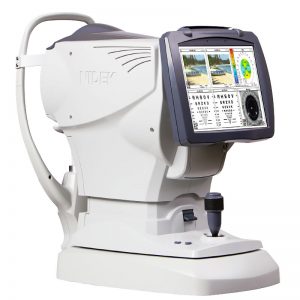
 After about nine years of having an automated refraction system in the practice, Heavin Maier, OD, of Eyes for Life in Spokane, Washington, couldn’t imagine practicing without it. When she added another lane of equipment, the Marco TRS Refraction System was part of that. “It’s part of our standard operating protocol now. The flow works well,” she says. She has other Marco technology in her practice, and it adds to the overall efficiency when the equipment “speaks” through the card system that moves patient data from the lensmeter and OPD Scan III Wavefront Aberrometer to the TRS system.
After about nine years of having an automated refraction system in the practice, Heavin Maier, OD, of Eyes for Life in Spokane, Washington, couldn’t imagine practicing without it. When she added another lane of equipment, the Marco TRS Refraction System was part of that. “It’s part of our standard operating protocol now. The flow works well,” she says. She has other Marco technology in her practice, and it adds to the overall efficiency when the equipment “speaks” through the card system that moves patient data from the lensmeter and OPD Scan III Wavefront Aberrometer to the TRS system.
Patients as decision-makers
What she loves about the process is the ease with which patients can make the decision on whether new eyewear will benefit them. “I hated having to dial in the prescription manually and show patients what the difference was between their current and new prescriptions. Keeping track of axis and cylinder and sphere shift was mind-boggling,” she says.
With the Marco equipment, it’s a simple toggle switch. “I can show them each eye individually, or I can show it as two eyes together,” she says.
She appreciates that it’s not up to her to make a judgment call or try to convince a patient that a prescription change is “big enough” to warrant new eyewear. “There have even been patients where I think they cannot possibly notice this change, but they immediately say, ‘Oh, that’s so much better.’”
When patients are assured that the new prescription will help them see more clearly or more comfortably, they’re happy to make the purchase.
 The patient experience
The patient experience
It’s important, too, that patients see that the practice invests in the patient experience. Since nearly all patients engage with the OPD and TRS systems, new patients have the immediate perception that the practice isn’t outdated or old-fashioned with its technology.
Goodbye, shoulder pain
Dr. Maier has been in practice for 19 years. “Within the first year of practicing, my shoulder was killing me,” she recalls. She began wondering whether the cost of doing manual refractions was going to involve her own comfort and shoulder mobility. “After switching to the TRS system, I realized that I was no longer in pain at the end of the day, so that’s priceless. I cannot imagine why there are doctors wrecking their shoulders,” she says.
She has gotten good support from her Marco team, and she credits Marco President Jocelyn Hamilton as a true professional committed to helping doctors succeed.
Dr. Maier says that she would have a very difficult time going back to a manual system. The Marco equipment she has provides her with a solid starting point for her prescriptions, and she uses that to achieve her endpoint more quickly. It saves her time showing patients the difference between old and new prescriptions and improves patient engagement in their own care decisions when changes in the prescription are numerically small. And she can walk out of her building at the end of the day without her shoulder throbbing.
Article originally published in Vision Source OD magazine. Learn more about Vision Source here.

